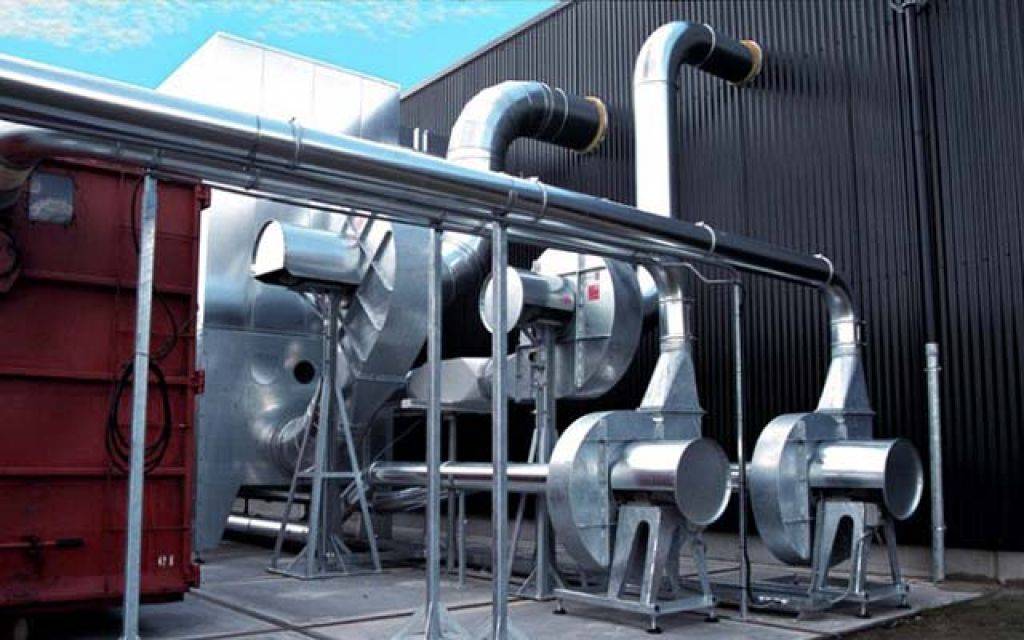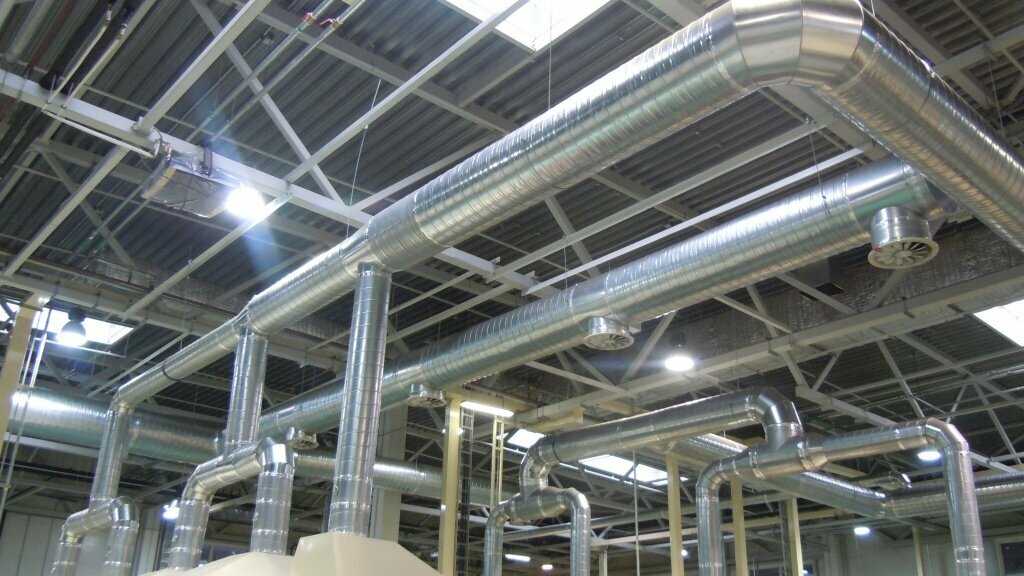Ventilation in industrial premises: what you need to know?
Ventilation in industrial premises is a critically important element of any production. Ensuring proper air quality in premises where production processes take place is a guarantee of safety, staff efficiency and stable quality of finished products. In conditions of intensive work, vapors, dust, gases, microparticles and other harmful impurities often accumulate in the air, which must be promptly removed. That is why a properly designed ventilation system is the basis of a healthy microclimate and long-term operation of equipment.
When designing industrial ventilation, it is important to take into account the specifics of production, the volume of air exchange, the number of people in the room, the types of technological processes that take place in chambers or workshops, as well as the required level of air purification. Calculation of ventilation systems should be carried out exclusively by professionals, as errors at this stage can lead to excess energy consumption, reduced efficiency, condensation or even emergency situations.
The company Ventilator.ua specializes in the design of industrial ventilation and provides a full range of services: from consultation and selection of equipment to calculation, installation and maintenance. Our engineers take into account all ventilation requirements - air exchange rate, air flow from the premises, type of ventilation (supply, exhaust or supply-exhaust), as well as the location of exhaust and supply chambers. All projects comply with modern safety and energy efficiency standards.
Ventilation of industrial production premises: features of the choice and effectiveness of the design of ventilation systems
We also offer a wide range of equipment for industrial premises - from industrial fans to automatic microclimate control systems. The equipment can be installed both in standard production premises and in chambers with increased humidity, temperature or dust concentration. All ventilation systems that we develop and implement have optimal performance and high efficiency. A properly selected ventilation solution allows you to save on energy resources and reduce maintenance costs.
The design of the ventilation system also involves integration with air conditioning and heating systems, which allows you to achieve a stable temperature regime at any time of the year. We help create a full-fledged environment with purified and filtered air, which is especially important in the pharmaceutical, food, metalworking and chemical industries. We also provide the possibility of zone control for flexible control of conditions in different parts of the room.
By contacting Ventilator.ua, you will receive not just equipment, but a comprehensive solution with a quality guarantee, support and after-sales service. Our telephone number for consultations: +38 (044) 238-24-81. We know everything about industrial ventilation — trust the experience of professionals!
Designing industrial ventilation for production premises: effective solutions for ventilation in the production sector

Industrial ventilation in production premises is one of the main elements of safe and effective work organization. In production premises without high-quality ventilation, harmful substances, dust, gases and vapors accumulate, which can negatively affect the health of employees. Ventilation systems in such conditions are necessary to ensure high-quality air exchange and create a comfortable microclimate.
Proper functioning of the ventilation system helps reduce the concentration of harmful substances, regulate temperature and humidity, and remove dust and other impurities from the air. Ventilation in industrial premises should ensure the removal of harmful emissions, as well as the supply of fresh air to maintain a balance in the microclimate.
Ventilation systems are designed individually for the needs of each facility, taking into account the specifics of production, the volume of pollution and the number of employees. The ventilation requirements established by current standards, as well as the parameters of general exchange ventilation, are necessarily taken into account.
Industrial ventilation: design of ventilation systems for industrial premises and production
Designing a ventilation system for production premises is a critical stage in creating comfortable and safe working conditions. The ventilation system must take into account all the features of production, the type of product, the location of ventilation chambers, the number of exhaust and supply air. Ventilation of industrial premises involves the use of equipment for production needs, taking into account exhaust ventilation and the necessary air exchange.
The design of industrial ventilation includes the calculation of temperature, humidity, air velocity parameters in the premises, as well as the selection of fans, filtration systems and types of air ducts. Ventilation systems of various configurations are installed, which ensure effective supply of fresh air and removal of air from the premises.
The online ventilation store Ventilator.ua offers professional equipment for industrial ventilation, including fans, filters, air purification systems, exhaust and supply units. We will help with the selection, calculation, installation of the ventilation system and its subsequent maintenance. Contact Ventilator.ua by phone: +38 (044) 238-24-81 for professional advice.
Main types of ventilation for industrial premises: features of designing ventilation systems for workshops, installation and energy efficiency
Different types of ventilation systems are used in industrial premises depending on the nature of production. The main ones are general exchange ventilation, local ventilation and supply and exhaust ventilation. General exchange ventilation is designed for uniform air distribution throughout the entire volume of the room, removal of harmful substances, maintenance of optimal temperature and humidity.
Local ventilation is used for direct removal of contaminants in workplaces. Supply and exhaust ventilation, especially with heat recovery, allows you to reduce heating and cooling costs and ensure energy efficiency. Ventilation systems are selected according to the principle of maximum air purification with minimal energy consumption.
Industrial premises require the installation of ventilation systems with a high level of filtration, a large volume of air exchange and resistance to aggressive environments. Typical solutions include the use of ventilation equipment of the following types:
- high-power fans;
- systems with deep cleaning filters.
Proper installation of ventilation for industrial premises involves precise compliance with project documentation, in particular, taking into account all production features. Industrial ventilation systems are installed using highly efficient fans, filters and chambers for exhaust and supply air.
Ventilation installation should be performed by professionals, as mistakes can affect the air quality in the premises. Installation of ventilation systems allows you to ensure ventilation of premises in accordance with modern standards, which helps reduce risks to the health of workers and product quality.
Ventilation of industrial facilities — it is not only about comfort, but also about safety and compliance with sanitary standards.
The online store Ventilator.ua provides equipment for any industrial facilities: workshops, warehouses, laboratories, pharmaceutical and food industries. You can order the design of a ventilation system from us, its installation and commissioning work.
Regulatory requirements for the design of industrial ventilation in production premises: ventilation systems for ventilation of industrial enterprises
Ventilation in industrial premises is regulated by a number of state standards and building codes. In particular, ventilation requirements provide for the mandatory provision of air exchange rates, permissible levels of concentration of harmful substances, compliance of ventilation systems with the type of production and operating conditions.
Ventilation must effectively remove harmful substances and supply fresh air. Ventilation systems are calculated taking into account the number of employees, area of premises, nature of technological processes, temperature and humidity. Ventilation equipment must meet safety requirements, have quality certificates and undergo technical testing before being put into operation.
Ventilation systems for industrial premises: how to ensure high-quality ventilation of industrial facilities

To maintain stable operation of the ventilation system, regular maintenance and cleaning of filters are provided. It is imperative to check the condition of the ventilation ducts and the tightness of the system. All these points must be performed in accordance with current instructions and state regulations.
The design of ventilation and air conditioning depends on the specifics of production. In each case, it is necessary to provide for the required number of fans, the level of air heating, the type of exhaust ventilation and microclimate parameters. Equipment for manufacturing enterprises is selected individually, taking into account the volume of air in the premises, type of products, number of employees and operating mode.
Industrial ventilation systems must maintain stable temperature and humidity parameters, save energy and increase the efficiency of production processes. Properly organized ventilation for industrial premises is the key to maintaining the health of personnel and the durability of equipment.
Factors for choosing ventilation equipment for ventilation of industrial premises: ventilation design, installation, energy efficiency and venventilation in different types of premises
The correct choice of ventilation equipment for industrial premises depends on many factors. Firstly, this is the type of production and the amount of harmful substances released in the process. Secondly, the volume of air exchange and the temperature regime that must be maintained in the room. Thirdly, the area and layout of the building.
The equipment must ensure a continuous supply of fresh air and removal of exhaust air with minimal energy consumption. For industrial enterprises, supply, exhaust, supply-exhaust systems equipped with fans, filters, and recuperators are usually used.
It is also important to consider the following parameters:
- equipment noise level;
- automatic control capability.
Modern ventilation systems installed in production facilities must ensure a continuous supply of fresh air and effective removal of air from the premises. Exhaust ventilation combined with supply ventilation is an ideal solution for enterprises with high levels of air pollution.
Working conditions are significantly improved when the ventilation system functions properly: reducing temperature, dust and harmful substance concentrations, optimizing air exchange. Ventilation for industrial enterprises allows you to increase labor productivity and reduce costs for cooling or heating air.
Provide the correct ventilation system design — means saving resources and reducing the risk of downtime in production.
Examples of ventilation solutions for industrial enterprises: industrial ventilation design, shop ventilation systems, installation and features of ventilation in production premises
Ventilation solutions for industrial premises depend on the specifics of production processes. For example, at chemical, pharmaceutical or food industry enterprises, ventilation must ensure intensive removal of vapors, dust and harmful gases. In the food shop, supply and exhaust ventilation with a high degree of filtration is used.
In metalworking shops - exhaust systems with local exhaust hoods near the machines. In pharmaceutical laboratories, clean air zones with excess pressure are mandatory. All these solutions are developed on the basis of accurate ventilation calculations and taking into account microclimate standards.
Choosing ventilation for industrial premises is impossible without a professional approach to designing a ventilation system. Every aspect is important here: from calculating the ventilation system to properly installing ventilation. The operating parameters of the fans must be sufficient to effectively process the air volumes in the premises.
Ventilation of industrial production: design, installation and operation of ventilation systems
Ventilation systems are installed taking into account the zoning of workshops, the presence of chambers for processing products, and the specifics of air pollution. Installation of equipment for manufacturing enterprises allows to achieve cost reduction and improve product quality.
Ventilation of industrial facilities must not only meet standards, but also take into account future maintenance, the possibility of modernization and adaptation to changes in production.
Ventilation equipment with high efficiency, low noise, and the possibility of automation is installed. Ventilation must provide stable air exchange, temperature, humidity and pressure maintenance. The online store Ventilator.ua offers ready-made solutions for various types of production, as well as individual turnkey ventilation systems.
Our engineers will carry out a full calculation, selection, installation of the ventilation system, and also guarantee technical maintenance. For a free consultation, please call:+38 (044) 238-24-81.



















Write a comment